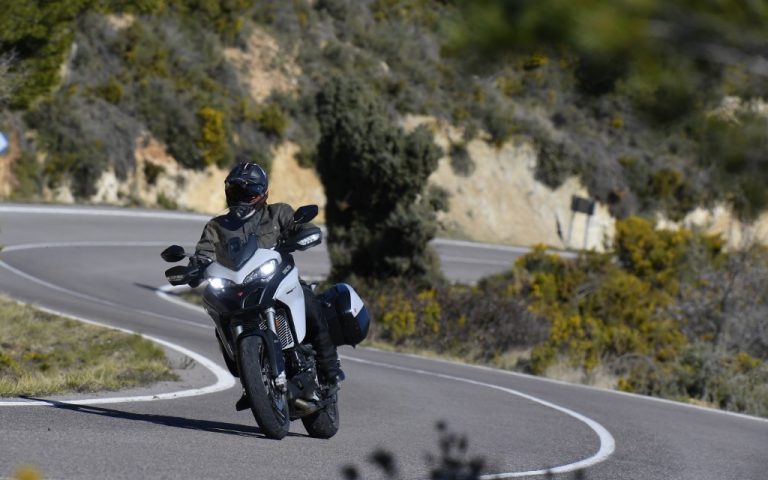Julian Challis reports back from the launch of the little brother in the Multistrada family, the 950 S.
Back in the late ‘70s, my brother and I spent a considerable amount of our time playing Top Trumps. Our favourite was obviously the motorcycle version, the range of bikes a truly bizarre mix of machines from odd French mopeds, familiar Japanese superbikes and obscure European commuters.
But the one card that would beat everything hands down was the Munch Mammoth. Powered by an NSU car engine, the Mammoth was bigger, faster and heavier than every other bike in the pack, and to accompany all the performance superlatives, the hand-built monster machine also had a similarly enormous price tag to match.
Fast forward to 2019 and although the Munch is long consigned to history, the trend within adventure bikes is showing a noticeable progression towards similarly massive figures. Power is heading rapidly towards the 200 bhp mark, capacities are now matching or even exceeding that of small cars and the prices, thanks perhaps to the increasing popularity of PCP schemes, are scampering happily towards £20,000.
So, against this backdrop, could Ducati’s facelifted Multistrada 950 really cut the mustard? Could a smaller-engined, lower-powered, cheaper bike really trump the mammoth machines? Could less really be more?
To answer the question, ABR headed out to the winter sun of Valencia for the launch of the new bike. Set in the uber-stylish Veles E Venta, a building constructed for the city’s hosting of the Americas Cup in 2007, Ducati put on a similarly stylish presentation to herald the arrival of the updated machine.
But for all the bright lights and cool videos on display, the reality of the changes to the new bike seemed somewhat overstated. Project Manager Stefano Tarabusi introduced the bike as having had a facelift, but actually the basic look of the bike had changed very little, and when he then went on to talk about the changes to the engine there was similarly little to discuss. This was confusing.
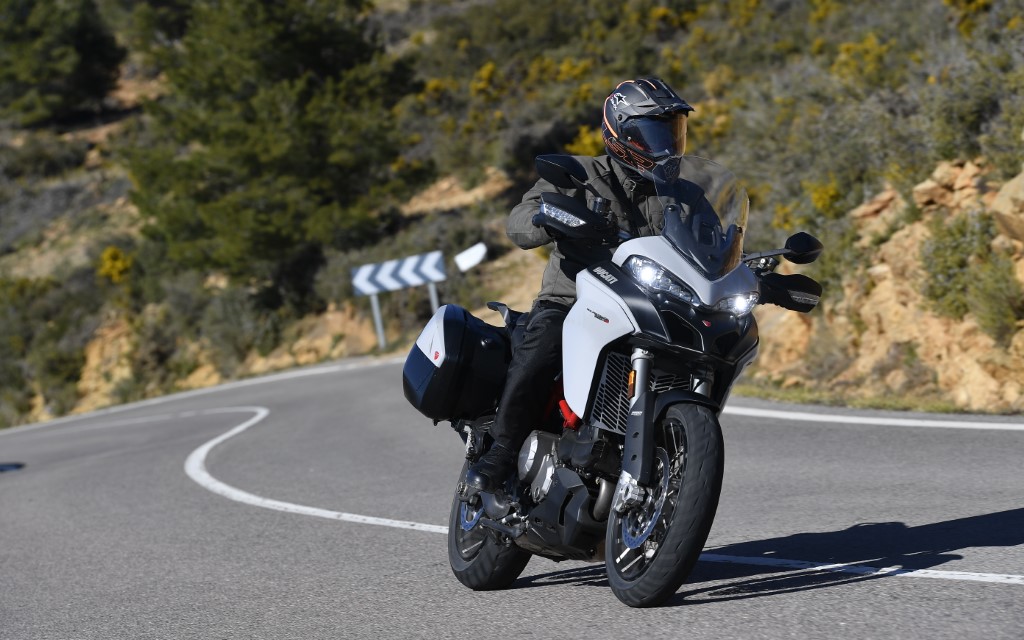
Same but different
So, let’s go back a bit to clarify how the bike had started and how the 2019 model compares. The first Multistrada was brought out some nine years ago back in 2010, but it was only two years ago that the diminutive 950 joined the line-up. Using the same powerplant that was so effective in the bonkers Hypermotard and the slightly more refined Supersport, the 937cc engine in the iconic V-twin formation is also the basis of the new Multistrada, wrapped in Ducati’s familiar trellis frame, now picked out in blood red.
For 2019, that engine remains almost identical in the new 950, Ducati working on the premise that it certainly wasn’t broke and definitely didn’t need fixing. Buyers loved the tractability of the smaller powerplant and although the 113 bhp on offer is not going to match the big numbers of its bigger sisters, it was plenty enough to turn even the most boring of roads into a personal playground.
It’s a similar story with the bodywork. The 950 already looked damn sexy in 2017, so the biggest change was to add the large side wings from the 1260, although for the 950 they are suitably colour-matched to the bike. All good but not exactly ground-breaking.
And then we get to the technology, and the reason that the 2019 bike is so much better, so much more enjoyable and so much more fun to ride than the version it replaces. Ducati has taken all the top-line electronic controls from the flagship bikes and added them lock, stock and barrel to the 950 and in a stroke turned it into a motorcycling masterpiece.
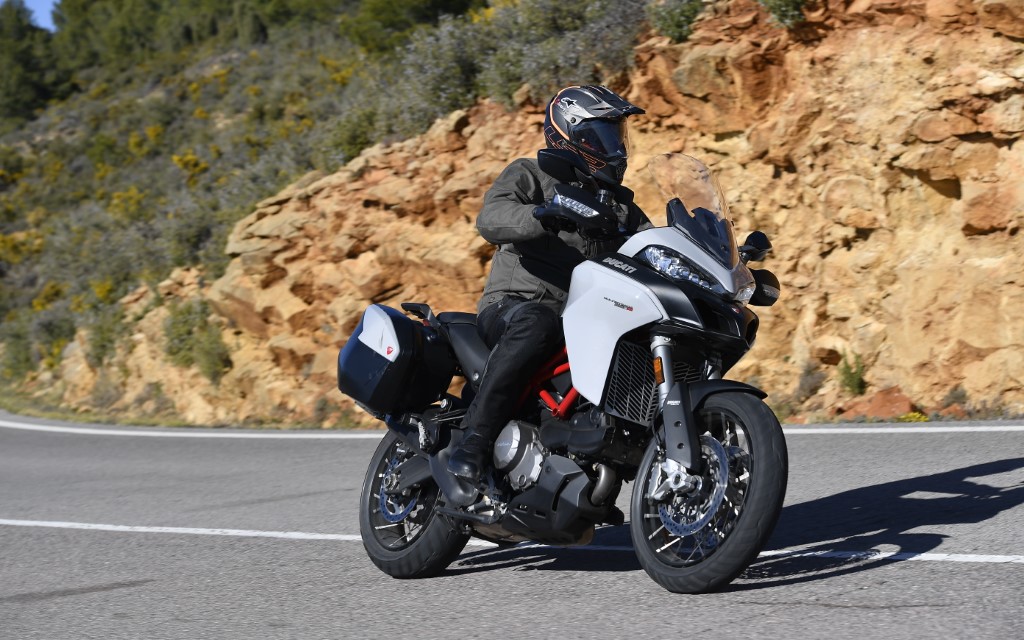
OK, so just to qualify that a tad – although the stock 950 has benefitted from a smattering of upgrades in terms of the Bosch IMU controlled cornering ABS, hill start technology, better screen and self-cancelling indicators, this is small potatoes compared to the 950 S that gets the whole shooting match from electronic suspension to keyless ignition, TFT screens and beyond. This was going to be good.
Grey is the new Red
The first chance to try the new bike and the new tech comes as we decamp the next day to a faceless trading estate on the outskirts of Valencia. For a man with marginal, if undiagnosed OCD, I was pleased to see the immaculate lines of identical 950 S lined up outside the Ducati warehouse, the curiously named ‘glossy grey’ paintwork glistening under the early morning sun.
The grey option is clearly seen as a premium upgrade compared to the usual Ducati red, and you can’t even buy the base model in grey. I’m sure I’ll be alone in the ABR office, but to my mind, anything but a red Ducati is about as wrong as Chocolate Limes…
Hopping on the machine and heading out of Valencia, we briefly picked up the coast road alongside the Mediterranean before heading west and inland towards the distant hills. The balance on the bike is instantly likeable, and the 950 drops in and out of the regular roundabouts with the lightest of input.
The bike runs Pirelli Scorpion Trail tyres which offer great feedback and grip no matter how the surface varies and inspire confidence from the off. Another innovation that you immediately notice on the roundabouts is the convenience of the self-cancelling indicators. As an occasional CBT instructor, my life would be made so much easier if these could be fitted to all learner bikes and thus avoid endless pleas for the novice riders to turn the damn things off just once…
Head for the Hills
As we left the city behind, I could appreciate the display, or HMI (Human Machine Interface), in front of me. Lifted straight from the 1260, the large, clear 5” TFT screen tells you everything you want to know and more. The rev counter swoops over the top of the speedometer, the gear selected is highlighted by the plastic detail on the left, and there’s a string of warning lights framing the display. Changing between information is through the back-lit toggle switches on the left bar, so you can check fuel range, trip meter, fuel consumption and the like.
Which is where we come to the suspension technology. Like the 1260, the 950 S now has the wonderfully named ‘Ducati Skyhook Suspension Evo’, or DSS if you prefer acronyms. Operating on the chunky 48mm USD forks and the offset rear shock absorber, the suspension is constantly monitored and adjusted to keep the bike composed and balanced at all times – hit a bump going into a corner and the system instantly stiffens up before returning things to an even keel milliseconds after.
The bike has 170mm of travel at both ends, but with the suspension keeping things quite so unruffled, you simply don’t notice how much the bike is or isn’t moving. While the name Skyhook seems odd, the algorithm the DSS system uses is actually referencing an imaginary point above the bike and keeping both ends balanced in relation to that point – like the bike is literally suspended on a hook in the sky. Clever stuff.
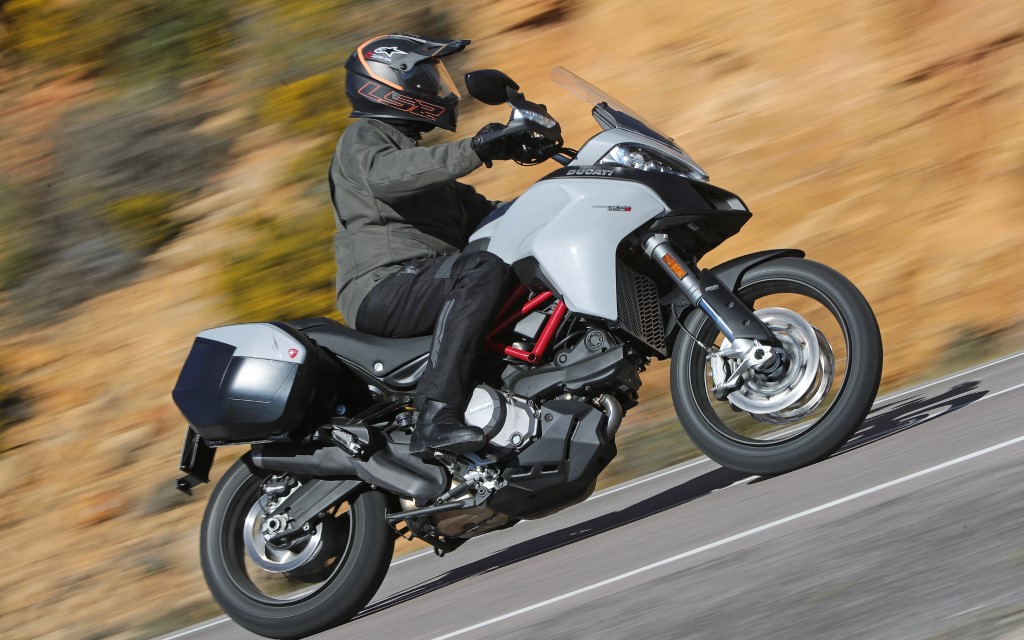
But this is not a one-stop shop to cover all riding styles, as the bike also has selectable riding modes, again as the 1260 does. You can select from the more leisurely Touring mode, through the controlled Urban mode, the peppy Sport mode and tantalisingly for me – the Enduro mode. To change the mode, which can be done on the fly if the throttle is closed, a prolonged push will affect a change, the new mode then showing up on the base of the TFT display.
Each mode will alter not only the suspension settings, but the traction control and the ABS performance and, in the case of Enduro and Urban, will limit the power to 75 bhp. And if you want even more control, you can toggle through to fine tune the settings through the intuitive controls and display.
Aside from the active settings, there are also the preload settings to consider, too, from ‘single rider’ mode to ‘single with luggage’, ‘pillion’ mode and ‘pillion with luggage’. Rumours that there is a secret setting for ‘overweight pillion with too much luggage’ are unfounded, but with over 400 different parameter combinations, you’re not likely to run out of options.
Our route took us high up into the hills behind Valencia, and the bike continued to impress whatever the scenery had planned. From fast, sweeping turns under dappled sunlight, to tight hairpins around the terracotta-tiled Spanish villages, the combination of the cavernous 53mm throttle bodies and the fly-by-wire throttle ensure perfect fuelling throughout the range, the spent gasses exiting through the super-model thin and similarly gorgeous new silencer.
The 950 has benefitted from the addition of a hydraulic clutch control unit for 2019 to work the self-servo slipper clutch, and the two units perform their duties with the quiet efficiency of an obedient butler. And should you wish to manage without the domestic staff, there’s an obligatory quick shift gear change unit to smooth out the clunks. If I could only remember to use it…
Killer, not filler
After a strong and suitably Italian double espresso at the first of the day’s stop, I’d done enough in the leisurely touring mode and decided to up the ante to Sport mode until lunch. I was tempted to stiffen up the preload too, by setting the mode as if the bike had luggage, as we had done with the 1260 on the off-road sections, but with most of the tarmac in great condition and my Christmas timber a distant memory, I kept the settings to rider only. And then I killed the bird.
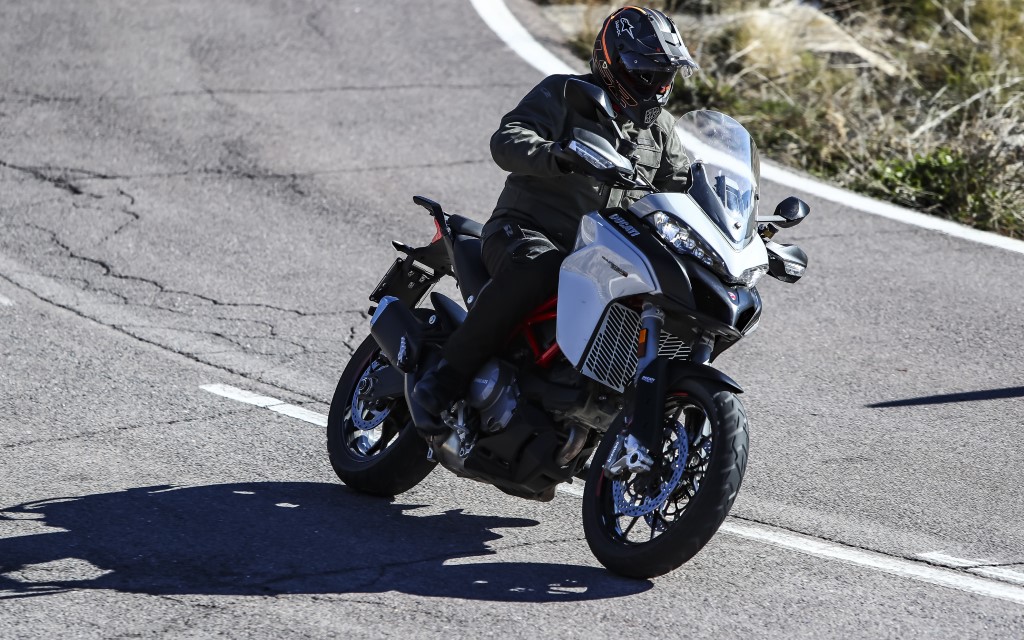
It wasn’t a deliberate act, not some kind of adrenaline-fuelled avicide, more a case of said bird being in the wrong place at the wrong time. With the engine and suspension now far more responsive and exciting, I was literally laughing to myself as to just how enjoyable the Multistrada is to ride.
The road dipped down to a sharp left and, as I hit the apex and accelerated out, the deep and guttural howl of the V-Twin clearly sent the ill-fated bird into panic, leaving the safety of a roadside bush for what would turn out to be its final flight. With a sickening, soft thud, the 950’s distinctive nose cone plucked the hapless creature from the air and it disappeared from view.
With those enormous nostrils protruding out at the front, I was seriously concerned it had been sucked into the oil cooler, but I couldn’t bring myself to stop and look. Sorry Señor pajaro.
We stopped for lunch after 90 miles at Montanejos, and I was relieved to find little evidence of the murder other than a few stray feathers. Suitably fortified with a delicious paella, Crème Catalan and more coffee, it was time to try out the 950 S with the touring pack.
For an additional premium of £1,028, you get a pair of colour-matched panniers (31-litre left and 26-litre right), heated grips and a centre stand. Choose the Sport pack and it’s a Termi can, billet water cover and LED indicators, Urban pack a top box, tank pocket and USB, and for the dirty-minded, the Enduro pack gets auxiliary lights, crash bars, rad and sump guards and big steel footpegs to replace the rather tiny OEM ones.
The seat height is identical at a comfortable 840mm, but there are lower and higher options for those closer to Warwick Davis or Stephen Merchant in stature.
The 950 S we were riding also had the optional side spoked wheels, but if you choose the alloys they are 500g lighter, as is the newly designed swingarm. The panniers on the bike sit nicely low and are not very wide, so they have little effect on the handling of the bike once you’ve upped the pre-load on the suspension.
As the lunch stop was at the top of a hill, I tried out the new hill start system, but it seemed annoyingly flawed as it self-releases after a fairly short time leaving you unexpectedly rolling backwards.
The road back down towards Valencia was a true delight and the little Multistrada responded with equally delightful handling and performance as we looped north towards Castillo Villamalefa before heading south. Without the bulk and physical size of the 1260, let alone the massive inertia in that huge engine, the 950 is wonderfully lighter of touch on the road.
It accelerates nimbly with fantastic roar as you snick up through the box, and when needed the massive Brembo monobloc brakes and 320mm discs bring everything back into line without even a hint of fuss or drama. The 950 uses a linked braking system in addition to the usual ABS and cornering ABS technology to add the effect of the front Brembos to that of the rear caliper and 265mm disc, which gives even the most nervous of riders incredible braking control.
The linking effect is reduced in Sport mode, but overall the brakes are just another illustration of how well this bike performs, the smaller Multistrada providing an arguably better riding experience than the 1260 in almost every circumstance.
Even ignoring the effect of rotating masses within the motor, there’s almost 50kg less mass to move around, and the consequent agility and flexibility that gives to the 950 is intoxicating. While the 1260 demands respect to get the best out of it, the little Multistrada needs none of it, just a twisty road and a handful of throttle.
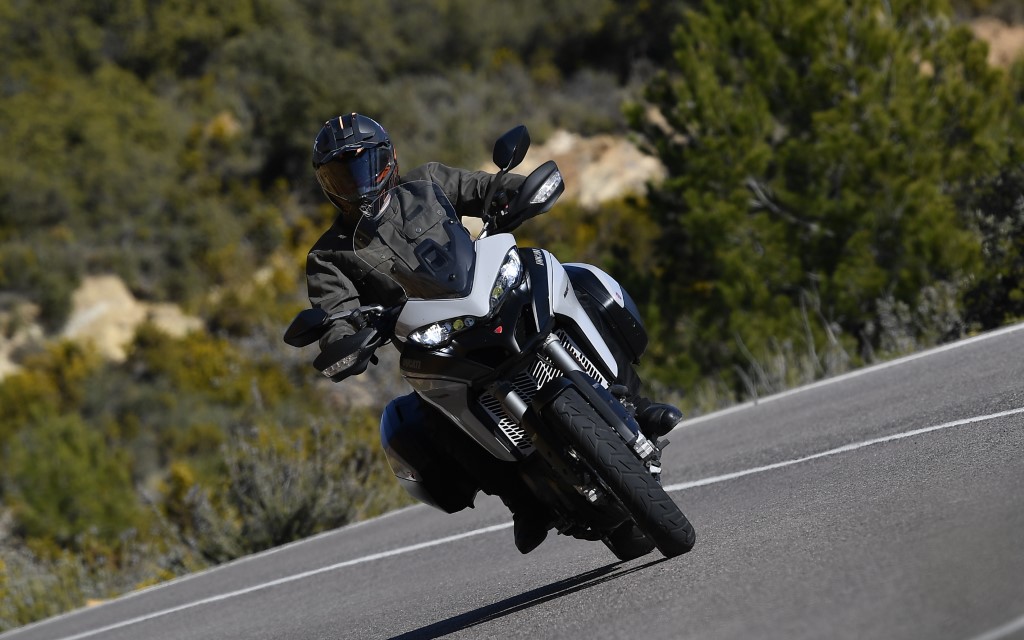
Fast back
We headed onto a motorway of sorts. With a clear road ahead and the sun beginning to dip towards the horizon, we could pull up the screen and open the throttle. Again, the 950 S responds with comforting predictability and poise.
It will pull through the gears deliciously thanks to the almost flat torque curve, the power building from 3500rpm right through to 9500 as the speedo passes through the mid-hundreds and up towards the twos. The 1260 would do this a bit more impressively and forcefully if required, but in reality, once you are pushing on at these speeds, there’s little to choose between the two brothers.
Coming Home
PRICE: £13,555 (£11,755 for standard Multistrada 950)
ENGINE: Liquid-cooled Testastretta L-Twin with desmodromic timing and 4 valves per cylinder
CAPACITY: 937cc
OUTPUT: 96bhp @ 9,000rpm
SUSPENSION: Front; 48mm fully-adjustable, USD Showa forks, full electronic compression and rebound adjustment using Ducati Skyhook Suspension Evo. Rear; Fully-adjustable monoshock with remote preload adjustment. Full electronic preload, compression and rebound adjustment using Ducati Skyhook Suspension Evo
BRAKES: Front; Twin 320 semi-floating discs with radially mounted Brembo monobloc 4-piston calipers with Bosch Cornering ABS. Rear; single 265mm disc with single floating piston caliper with Bosch Cornering ABS
WEIGHT: 230kg
TANK CAPACITY: 20 litres
SEAT HEIGHT: 840 standard, 820mm with low seat, 860mm with high seat
With the best of the day behind us, it was a gentle return to the outskirts of Valencia to drop off the bikes. We had travelled an unexpectedly long distance for a launch, but aboard the 950 S Multistrada not one of the 221 miles felt a chore.
With the addition of usable and sensible riding technology, Ducati has taken the bike into another class. It’s no longer the poorer sibling of the all-conquering 1260, it’s a genuine alternative that can compete on an equal footing to the bigger bike and, in many cases, come out on top.
Slap Appy
As you might expect, the Multistrada 950 S hooked up to the Ducati Link App, downloadable onto your smartphone, but sadly not a Nokia 3310. In the ‘Journey’ mode, a combination of both the load and riding modes, you can fine-tune and personalise your bike’s performance from ABS to traction control from the comfort of your sofa. The app will also keep note of your bike’s service schedule (an impressive 9,000km (5,500 miles) for the interim and 18,000 (11,000 miles) for the full Desmo service) contains the full owner’s manual, and will also locate your nearest dealer should the need arise. It will also allow you to share your rides and experiences with other Ducati owners, but thankfully stops short of organising swingers parties…
ABR Verdict
As a commuter
Given the modest dimensions and slimish profile of the 950 S, we can see the bike making a cracking commuter if that’s really what you want to do with Bologna’s finest. It’s even got an Urban mode to allow you to trickle between the traffic, or you can just hoon through in Sport mode!
As a weekend tourer
It’s hard to imagine a finer machine for weekend shenanigans than the lil’ Multistrada. From screeching round the B-roads to opening up the taps on the A roads and dual carriageways, the 950 will bring a grin from Friday to Monday morning. The soundtrack? A bit of Tom Petty would be perfect.
As an off-roader
The 950 S is halfway to becoming an enduro bike, having a ride mode already programmed in and being homologated for Pirelli Scorpion Rally hoops. OK, it’s heavy compared to a KTM EXC, but up against a GSA or 1260 Enduro, it’s positively sylph-like. Fit the tyres, whack up the pre-load and give it a go!
As a continental road tourer
Keeping with the theme of a competent allrounder, we can see the Ducati being used regularly for weeks away exploring the finest roads in the world. And, what’s more, with that peachy motor and handling, you’ll love riding them too.
As an rtw overlander
OK so were less sure on this one as few people that circumnavigate the globe seem to choose a Ducati as the weapon of choice (though Henry Crew did recently return from a round the world ride on a Scrambler) – there must be a reason for this. That said, we can’t see it and the 950 would make a pretty good Charley to your Ewan.
As a pillion carrier
No complaints are likely from the back-seat rider as the 950 S has great comfort for both rider and pillion and, being a stepped seat, they can even see where you’re going. On the minus side, they can also see how fast you are going there too…

